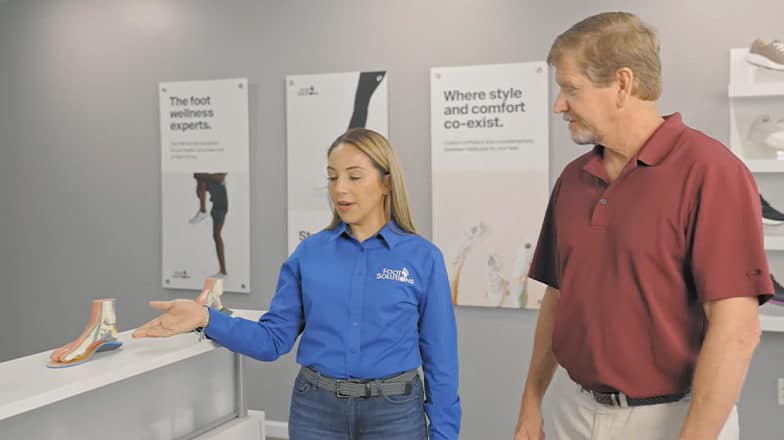Diabetic Foot
Diabetes affects over 30 million Americans and is classified into two different types: Type 1 and Type two. Type 1 is usually associated with juvenile diabetes and is often linked to heredity.
Type two, commonly referred to as adult-onset diabetes, is characterized by elevated blood sugars, often in people who are overweight or have not attended to their diet properly. Diabetics must pay particular attention to their feet as they are at risk for developing complications that can lead to foot and lower leg amputation and even death.

What is Diabetic Foot?
Video transcriptWhat is Diabetic Foot? Transcript
(This transcript is not meant to be a substitute for professional medical advice, diagnosis, or treatment. Always seek the advice of your physician with any questions you may have regarding a medical condition. Never disregard professional medical advice or delay in seeking it because of something you have read or seen on this website. If you think you may have a medical emergency, call your doctor, go to the emergency department, or call 911 immediately.)
Hello, I’m Donna Robertson, Head of Training and Chief Pedorthist for Foot Solutions. Today we are going to discuss a common pathology known as Diabetic Foot. According to the CDC, Diabetes affects over 34 million Americans. Diabetes is a serious disease that can develop from the lack of insulin production in the body or the inability of the body’s insulin to perform its normal everyday functions. Insulin is a substance produced from the pancreas gland that helps process the food we eat and turn it into energy. Type two, commonly referred to as adult-onset diabetes, is characterized by elevated blood sugars, often in people who are overweight or have not attended to their diet properly. Diabetics must pay particular attention to their feet as they are at risk for developing complications that can lead to foot and lower leg amputation and even death. The term “Diabetic Foot” encompasses a number of symptoms, including: Neuropathy, which is nerve damage accompanied often by tingling, pain, and numbness Degenerative structure and shape of the foot The development of Ulcers Infection from untreated blisters; and A loss of balance while walking and standing There are numerous complications associated with diabetes. Diabetes disrupts the vascular system, affecting many areas of the body, such as the eyes, kidneys, legs, and feet. This can lead to peripheral neuropathy (nerve damage) in the feet. In fact, diabetes is the most common cause of peripheral neuropathy. Neuropathy can lead to a dangerous foot condition called Charcot Foot, a degenerative process where the structure and shape of the foot collapse due to undetected injury creating a deformity. Charcot Foot can lead to ulcers in the feet that are difficult to heal, often resulting in amputation and even death. High blood sugar damages the vascular system and nerve fibers, especially in the feet and legs affecting both sensory nerves and the proprioceptors (the nerves that tell your body where it is in relation to space, e.g. where your foot is relative to the floor, the stairs, etc.). This nerve damage results in sensations that range from tingling, to pain or numbness. For some people, the symptoms can be mild, while for others they can be severe, disabling and even fatal. Because diabetic neuropathy affects the nerves of the feet, even small injuries such as a blister or rubbing inside a shoe can go undetected. Because shoes are a warm, moist environment, bacteria grows quickly. This can lead to infection, which can be difficult to treat as the blood supply to neuropathic feet is compromised due to vascular damage. Infections that won’t heal can quickly turn into diabetic ulcers (injury into the deeper layers of tissue) which dramatically increase the risk of amputation of the affected area. In the next video we will discuss recommended treatments and how Foot Solutions partners with your doctor to address Diabetic Foot. To learn more, make an appointment with your local Foot Solutions Pedorthist or visit www.footsolutions.ca. Your feet are the foundation of your health. Let us take care of them for you.

Twelve Common Treatments for Diabetic Foot
Video transcriptTwelve Common Treatments for Diabetic Foot Transcript
(This transcript is not meant to be a substitute for professional medical advice, diagnosis, or treatment. Always seek the advice of your physician with any questions you may have regarding a medical condition. Never disregard professional medical advice or delay in seeking it because of something you have read or seen on this website. If you think you may have a medical emergency, call your doctor, go to the emergency department, or call 911 immediately.)
Hello, I’m Donna Robertson, Head of Training and Chief Pedorthist for Foot Solutions. In a previous video we outlined a foot condition known as Diabetic Foot. Today we are going to discuss common treatments for this condition. First, it’s important to note, as with all medical conditions, it is important for you to remain in regular contact and consult with your doctor on all recommended treatments. If you have diabetic foot, here a dozen ways to properly care for your feet as well as some products and solutions offered by Foot Solutions that can address the health of your feet. Inspect your feet daily, including between the toes. Wash your feet daily. Dry carefully, especially between the toes. Avoid extreme temperatures. Inspect the insides of your shoes. Wear properly fitted shoes and socks at all times – never go barefoot. Protect your feet from hot and cold. Always wear seamless socks with your shoes. Cut your nails straight across, using an emery board to file corners. Wiggle your toes and move your ankles up and down for 5 minutes 2 or 3 times a day to increase blood flow to your feet. Ask your doctor to plan an exercise program that is right for you. Call your doctor immediately if you have a cut, sore, blister or bruise that does not heal after one day. Get regular foot examinations If you have diabetes, it is vitally important that you examine your feet regularly, even if you do not have peripheral neuropathy. It is not uncommon for diabetics to not realize that they have neuropathy as it can present with a gradual numbing of the foot. Any small injury, left undetected, can lead to complications that can result in amputation. Pressure and friction are the enemies of diabetic feet. Shoes should be fitted by a shoe fitting expert such as those we have at Foot Solutions. At Foot Solutions, we can help you stay comfortable and healthy on your feet, especially if you have diabetic foot. Many of our stores are Medicare accredited and are designed to help people just like you. We can properly fit you in supportive and athletic, casual, and dress shoes as well as wellness shoes to help you walk properly and correct your balance. As well, our arch supports and custom-fitted, custom-crafted orthotic insoles can help your feet stay healthy inside your footwear. To learn more, make an appointment with your local Foot Solutions Pedorthist or visit www.footsolutions.ca. Your feet are the foundation of your health. Let us take care of them for you.

What is Foot Solutions?
Video transcriptWhat is Foot Solutions? Transcript
(This transcript is not meant to be a substitute for professional medical advice, diagnosis, or treatment. Always seek the advice of your physician with any questions you may have regarding a medical condition. Never disregard professional medical advice or delay in seeking it because of something you have read or seen on this website. If you think you may have a medical emergency, call your doctor, go to the emergency department, or call 911 immediately.)
For over 20 years, Foot Solutions has been evaluating, solving, and preventing foot and joint issues for people just like you.Our highly trained board certified foot specialists are available at our retail locations to expertly fit you in a truly custom orthotic and recommend the perfect footwear from our collection of stylish international brands.We are proud to have thousands of positive reviews online, evidencing the care and attention that defines our service. At Foot Solutions, you will meet men and women passionate about foot and joint health and eager to provide you with a meaningful, first-class experience.Come into Foot Solutions and see for yourself how visiting with one of our specialists can improve your quality of life.
Symptoms, Causes and Common Treatments
Diabetic Foot
Symptoms
- Neuropathy (nerve damage) – tingling, pain, numbness
- Degenerative structure and shape of foot
- Ulcers
- Infection from untreated blisters
Complications Related to Diabetes
There are numerous complications associated with diabetes. Diabetes disrupts the vascular system, affecting many areas of the body, such as the eyes, kidneys, legs, and feet. This can lead to peripheral neuropathy (nerve damage) in the feet. In fact, diabetes is the most common cause of peripheral neuropathy. Neuropathy can lead to a dangerous foot condition called Charcot Foot, a degenerative process where the structure and shape of the foot collapse due to undetected injury, thus creating a deformity. Charcot Foot can lead to ulcers in the feet that are difficult to heal, often resulting in amputation and even death. High blood sugar damages the vascular system and nerve fibers, especially in the feet and legs affecting both sensory nerves and the proprioceptors (the nerves that tell your body where it is in relation to space, e.g. where your foot is relative to the floor, the stairs, etc.). This nerve damage results in sensations that range from tingling, to pain or numbness. For some people, the symptoms can be mild, while for others they can be severe, disabling, and even fatal. Because diabetic neuropathy affects the nerves of the feet, even small injuries such as a blister or rubbing inside a shoe can go undetected. Because shoes are a warm, moist environment, bacteria grows quickly. This can lead to infection, which can be difficult to address as the blood supply to neuropathic feet is compromised due to vascular damage. Infections that won’t heal can quickly turn into diabetic ulcers (injury into the deeper layers of tissue) which dramatically increase the risk of amputation of the affected area.
Causes
- Elevated blood sugar
- Damage to the vascular system
- Damage to nerve fibers
- Obesity/overweight
Common Treatments
- Inspect your feet daily, including between the toes.
- Wash your feet daily. Dry carefully, especially between the toes.
- Avoid extreme temperatures.
- Inspect the insides of your shoes.
- Wear properly fitted shoes and socks at all times – never go barefoot.
- Protect your feet from hot and cold.
- Always wear seamless socks with your shoes.
- Cut your nails straight across, using an emery board to file corners.
- Wiggle your toes and move your ankles up and down for 5 minutes 2 or 3 times a day to increase blood flow to your feet.
- Ask your doctor to plan an exercise program that is right for you.
- Call your doctor immediately if you have a cut, sore, blister or bruise that does not heal after one day.
- Get regular foot examinations
Solutions to Diabetic Foot Issues
If you have diabetes, it is vitally important that you examine your feet regularly, even if you do not have peripheral neuropathy. It is not uncommon for diabetics to not realize that they have neuropathy as it can present with a gradual numbing of the foot. Any small injury, left undetected, can lead to complications that can result in amputation. Pressure and friction are the enemies of diabetic feet. Shoes should be fitted by a shoe fitting expert (Pedorthist) who can assure that the shoes will properly fit and support the feet, reducing the risk of injury from shoes that are too tight or are likely to rub or cause injury. Excessive pressure causes calluses and corns, which can easily lead to an injury which can be hard to heal in a diabetic foot. The best way to reduce pressure points and improve foot function is through the use of arch supports. If you have Charcot Foot, at a minimum, you require custom arch supports (orthotics) and properly fitted shoes. You may require custom shoes. Only get your footwear from a certified Pedorthist (C.Ped.) or Orthotist/Prosthetist (CPO) to ensure you protect and care for your very special, at-risk feet. Call Foot Solutions to make an appointment with one of our certified Pedorthists.
Find your local store to speak to a Foot Solutions Expert
Find a Store Near You
Foot Solutions Products
- Supportive athletic, casual or dress shoes
- Wellness shoes to help you walk properly and correct your balance
- Off-the-shelf arch supports
- Custom-fitted, custom-crafted arch supports


